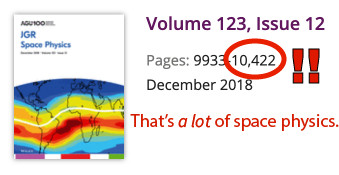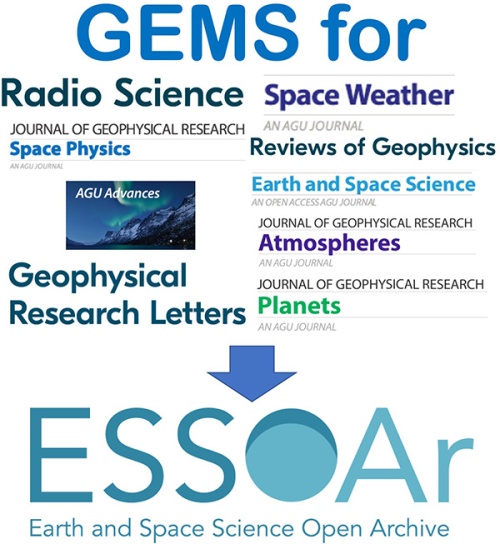Senior Editor Tamas Gombosi’s second editorial, published in November 1992, just a month after his first introductory editorial that I wrote about last week, is a fascinating fulmination about a perennial topic – too many papers of too little scientific value. He even touches on the larger issue of being “expected to do more science with fewer resources,” which perhaps drives the first problem of publishing incremental advancements in order “to create the appearance of increased scientific productivity.” He also laments a decline in subscriptions as the journal gets bigger each year. Remember that this came at a time before online publishing, when journals were physical magazines and took up space on your shelf. Finally, he notes that more papers means more refereeing work for the community.

JGR Space Physics has exceeded 10,000 pages for all 5 years that I have been Editor in Chief, and is on track to do this again in 2019. Its page count had not broken into the 5-digit realm until then.
Gombosi concludes like this:
“I would like to convince all of you to write concise papers with clear scientific motivations, papers which not only are interesting to read but also address and advance the subject in a meaningful way…I hope that as a community we will reverse the present trend and will find reading papers almost as enjoyable and rewarding as writing them.”
Did we reverse it? Are we reading more than we used to? I have no hard evidence easily available on this point, but I suspect not, even with the advent of online publishing and the digital availability of everything we write.
This article was followed, just a month later, by a guest editorial by George Withbroe from NASA HQ. He wrote to concur with Gombosi’s assessment of the issue and voice concern about measuring productivity with the number of papers from a person or group rather than the quality of those papers. The quantity versus quality issue runs parallel to the debate over the growing physical expansion of the journal on people’s office shelves. Withbroe highlights his own experience being faced with a choice of publishing one large paper or several shorter ones. He would have us choose one comprehensive paper, but urges us to write it in as concise a manner as possible to minimize the page count.
This all goes with the Brevity editorial of Alex Dessler twenty-four years earlier. Apparently, the issue of publishing more than any one person can read has been an issue for many decades.
The question begs to be asked: do we have a problem?
I agree in general with the “brevity” mantra and being “concise” in your writing. I think that removing excess verbiage is a skill that we need to hone. Some will argue that disk space is cheap, so why not write verbose papers? Why not include everything relevant, and even some parts that are only marginally useful? Why have a Publication Unit limit on JGR Space Physics articles, above which fees kick in? Someone might want to read it, so it should be there, right?
I think that we should strive for being as focused as we can. You will engage better with your readers if you keep the writing targeted at a central theme.
Which brings me to the other point – I disagree that there are too many papers published. Yes, JGR Space Physics publishes more papers than I want to read in a year, but this is not a problem because the journal spans more than any one person’s specific research interests. With the current editorial workload and workflow, there is always the chance of a few LPUs getting through to acceptance (the LPU, or “least publishable unit,” is a term I have heard Andy Nagy say, and warn against, since my first year in grad school). Could we be more selective in what we accept for publication at JGR Space Physics? I leave that to the next EiC (rumor is that the announcement is close).
I do not think that we want to go the other extreme from LPUs and publish only long treatises with so many findings that they risk becoming confusing, rambling, and tedious. Furthermore, very long papers with many findings make it difficult to summarize the key take-away points. Personally, I really like the length of paper that we typically publish. Furthermore, I really like AGU’s adoption of Key Points because I think they help us focus each paper on only a few significant new findings.
A final comment: I find it interesting that these editorials were written many years before Hirsch proposed his famous h-index (in 2005). Although it has its drawbacks, the h-index attempts to balance quality and quantity to assess a person’s productivity and impact on a field. It seems to be the dominant metric for this task right now. The h-index does not penalize you for publishing lots of short papers, but a long and comprehensive one might accumulate more citations because its numerous findings have a multi-faceted appeal. Which path is best to bump up your h-index? There is probably a study in existence about which of these styles (many short papers versus fewer but more robust ones) will optimize your h-index, but I don’t have it handy.
Feel free to comment below on these topics.






